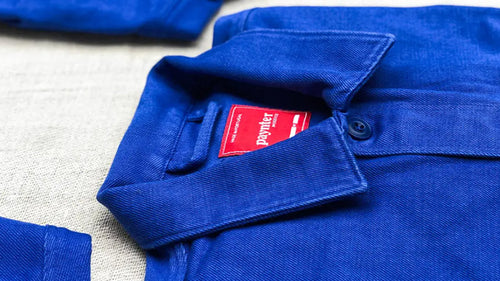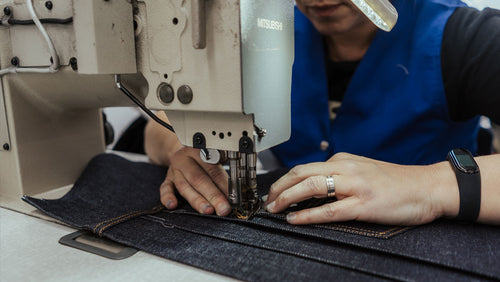An original piece by Alec Leach commissioned by Paynter.
Here’s how things normally go in fashion: you come up with some cool ideas, and six months to a year later those ideas get turned into garments by a massive network of suppliers, factories and mills. Once those garments have been produced and are in the shops, you cross your fingers and hope you sell them all in one season. But because fashion has such a short attention span (one that’s only getting shorter), ideas are only really valid for a few months, which means things get old real quick.
That’s obviously bad, but it gets really bad when you remember that fashion is what’s known as a “volume business” — i.e., you don’t make the shareholders happy unless you’re selling loads of stuff. So, all the biggest brands at the top of the industry want to sell mountains of stuff, but at the same time the industry has such a short attention span that all those brands need to be constantly selling mountains of stuff to keep up with it all. Can you see where this is going?

Fashion has a huge waste problem. Actually, problem doesn’t really cut it — it’s a crisis. It’s estimated that between 80 and 150 billion garments are produced every year, for just 7.9 billion human beings. That’s between 10 and 18 garments for every single human being on the planet, from a new-born baby to your grandparents. And what happens to all of this stuff?
The obvious answer is that we, the consumers, buy it all and then throw it away — that’s a story for another day. But the fashion industry itself has a huge waste problem — nobody ever sells every single thing that they make. At the end of each season, brands are left with piles of stuff that they didn’t sell — and that’s where the huge markdowns and the outlets come in. And if you’ve still got some stuff left over after all of that then, well, things aren’t looking so good. Maybe your leftovers end up exported to a poorer country for someone else to deal with, or they end up in a landfill, slashed or incinerated. But no matter what happens, it’s not actually that big of a deal for the industry — in the eyes of the law there’s nothing wrong with making tons of stuff that nobody buys, then throwing it all away. If anything, you get to write it all off as a loss on your tax return.

Sounds pretty depressing, doesn’t it? Well just wait until you hear about the pollution, carbon emissions, toxic chemicals, deforestation, obliterated biodiversity, human rights violations and poverty wages that are also tied up in the way the industry works right now. This sprawling, destructive system might be terrible for the planet, but it’s very, very good at making tons of stuff, and the brands that are the best at selling tons of stuff make tons and tons of money.
All of this is to say that waste is built into the fashion industry. Everyone, from the high street to the runway, operates on the same model: make loads of stuff, hope you sell it all, and if you don’t then it’s somebody else’s problem. Despite all the corporate pledges, certifications and “sustainable” capsule collections out there, the majority of the industry is pretty happy with the way things are, because they’re making all that money. They’re also not legally responsible for all this mess, and that suits them just fine.

So, what do we do about all of it? The truth is the fashion industry as a whole will only ever be better when governments finally — fiiinally — step in and regulate it, so that all that waste, pollution and exploitation becomes a liability rather than a side-effect. We need a system where good behaviour is the norm, not an option. But in the meantime, what does this mean for our shopping habits?
The good news is that there are plenty of innovative brands out there pioneering new, less wasteful and less harmful ways of doing business.
Paynter’s innovative way of doing business, where batches of jackets are sold via preorder, means that there’s no stock left over once it’s all said and done — every single piece sold will be going to a happy customer. And because they only release one piece at a time, there’s plenty of space in the calendar to make sure it’s done right — no rushing something out just because it’s hot right now.

Using great fabrics guarantees that your jacket will last for years to come, and made in factories in the EU with the assurance that everyone is treated fairly. And, more philosophically, taking a behind-the-scenes glimpse at how it's all made will hopefully help you appreciate just how much time, energy and human ingenuity goes into each garment you buy — and why it’s so important to take care of them all. And sure, the preorder model is a pretty slow way of doing things, but that’s actually how it should be. Taking it slower gives you more space to think about whether you really want another jacket in your life, rather than sleepwalking into yet another regret purchase because it was a “bargain” at 75% off.

Paynter’s business model is just one way of making clothes without all those wasteful, destructive bad habits. There are also brands who produce small collections of sturdy wardrobe staples that are completely traceable across the entire supply chain and the makers of gorgeous handmade treasures, like Santangelo jewellery, who makes everything by hand using materials found lurking in old jewellery suppliers. Story MFG runs what looks like a conventional supply chain, until you realise everyone’s an artisan and getting paid fairly and using natural materials. And let’s not forget second hand and rental, which challenge our conventional idea of what “new” really means. Finally, there’s a lot to be said for brands that simply make something to last, and do it using lower-impact materials — like UNNA, a contemporary activewear brand from Stockholm.

It's important to support these businesses because they are truly contributing to a better industry, even if they're small. Yes, the only way fashion’s giant, destructive supply chain will be reformed for the better is through regulation and accountability — aka politics! — but in the here and now, our spending power really counts.
One pleasant and very important side effect of supporting innovative new fashion businesses like the ones I’ve talked about here is that they avoid so many of capital-f fashion's pitfalls — the bad quality, lightning-fast trends, the built in obsolescence that comes from every impulse purchase. Re-thinking where and how you spend your money is an opportunity to do it so much better — slower, yes, but it’s a marathon, not a sprint. Do you need a new jacket every season, or a few great ones to last a lifetime?
Alec Leach is an author and strategist working in sustainability. His debut book, “The World Is On Fire But We’re Still Buying Shoes”, is out now.
Illustrations by Dick Carroll for Paynter.



